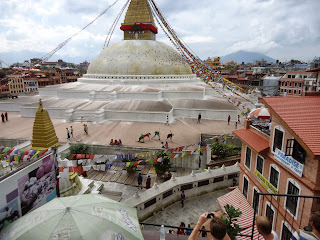Bandh (strike) #2: just a continuation of the last one they had (see Teej. or the post before teej). This time, there was a strike against the strike because people were grumbly that the bandh was hindering their daily lives. A Maoist group wanted their murderer back. I'm not sure if they got him...but I do know the gang rapists in India got the death penalty. I'm really bad at reading the entire newspaper.
The two upper pictures are of the Kathmandu streets right in the city. Empty! I almost forgot there was a bandh until I realized I didn't need to wear my mask because there weren't any buses farting black exhaust all the way down the road. It was a great walk to school. There were motorcycles and other pedestrians, but otherwise it was so quiet (no horns), and I didn't have to do the Jesus Walk* through traffic.
*In the states, I usually wait til both ways are clear. Here, you have to
wait for one way, walk half way and stop in the middle of traffic, then
wait til the other side is clear/until there's a reasonable gap. Jesus Walking occurs when you time your walk so that turning cars, rogue motorcycles, and bicycles in your blind spot are make a clear path for a brief moment and you make it straight across
the street with out stopping, after which you
exclaim "I didn't get hit! I feel like Jesus!"
Haterika!! This is Nepal's version of "Dern it!" We like to spit this out every now and then at the program center. Anyways as I was walking home, my flipflops from 8th grade finally broke. 10 minutes away from home, I didn't want to go half bare foot and get a worm, tetanus, or dried dung all over my foot. I turned me shoe around and tied my bandana to the shoe strap, and then to my ankle. It kind of kept the shoe on, but I pretended like I was a bad ass, street-smart person as I limped home.
My first Nepali language exam was Thursday (the bandh day). I did really well! This is my creepy person with his body parts labeled (above). Below is the Devnagari script. It's the coolest.
Top to bottom, I wrote malaai (to me), kukur (dog), guru (teacher), daai
(older brother), dui (two), tin (three), chini (sugar), pakaaunu (to
cook), aamaa (mom), bhaat (rice), git (song).
For my birthday, the language teachers gave me this potato of my face. The back says "my name is potato Durga." They call people potato heads on occasion when we're acting...like potato heads. They gave me this before they handed back test results, so I was afraid I screwed up on the test. But no, it must just be a Nepali birthday thing (?)

At lunch, the cooks also made a cake for me! It says Durga, and apparently I'm turning 1 year old. The swastika is not Nazi related. In Hinduism, it is actually a sign of auspiciousness and luck.
After class, my friend and I took the bus home, then back downtown for the first time. It was super cheap and really easy to use, so we'll probably take the bus more often now. At home, my aamaa gave me a kurtaa (just the fabric, it still has to be tailored) and my didi gave me some nice earrings. We met up with most of our classmates and went to a restaurant. I had my first legal drink (which doesn't matter in Nepal) - a tequila sunrise. It was pretty good. I had to leave early though, and didn't stay for dinner. They wouldn't let me pay for my drink.
Next I caught a cab to Patan, where my sisters live and spent the night. Kanchan's birthday was the day before mine - she turned 23. I had dinner with Kanchan, then had cake and exchanged presents with her and the rest of her house. First though, there was a lot of singing and praying which was awkward but it passed. Kanchan and Smita were really generous and got me some a bag, a dress, and some jewelery. Ooops...I just got Kanchan some cookies and nail polish. I decided I'd stay for their church service the next day.
Before church, I did henna on 2 of the girls in Kanchan's house. It was fun! I also painted Kanchan's left fingernails. She didn't want the other hand because they eat rice with it. Makes sense. Later, Kanchan got my measurements and gave them to Sommaya. She is also making a kurtaa for me!
Church wasn't too bad. It was 90% singing. After an hour they kicked me out with the kids, Kanchan, and a couple other girls and we taught the kids some songs and stuff. The services and the kid part were all in Nepali which was good. I can understand things a little better, but it's still a struggle. I saw Kanchan's fiance, but he was busy the whole time playing the guitar for the whole congregation. Kanchan hopes to get formally engaged in November sometime, then married in December. They are unsure because elections are in mid November, along with strikes and who knows what. So their date is not set yet.
Smita is working a ton. I think she balances her time between 2 hospitals.
Monday, we go to Palpa for a week. No computer = no blog posts!























































